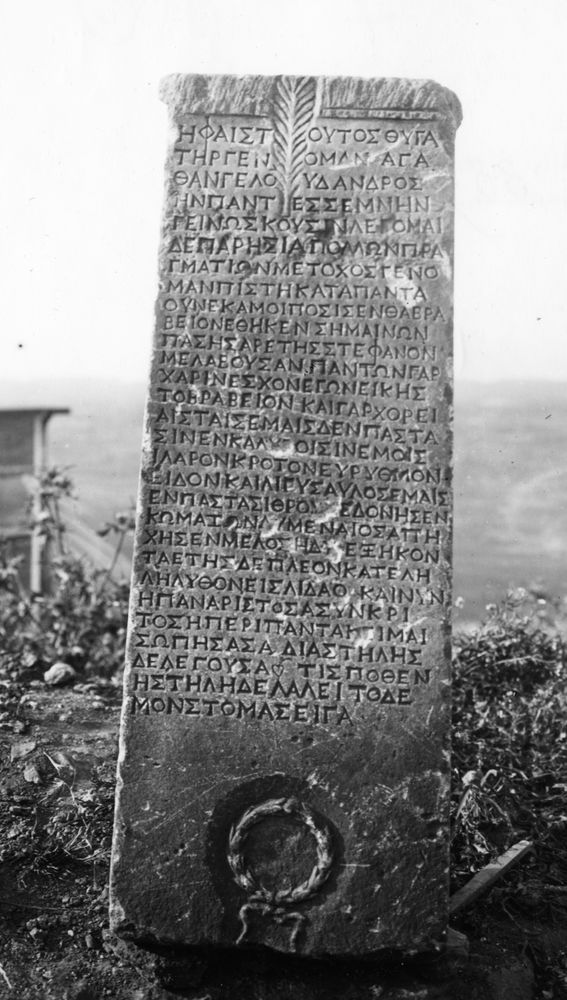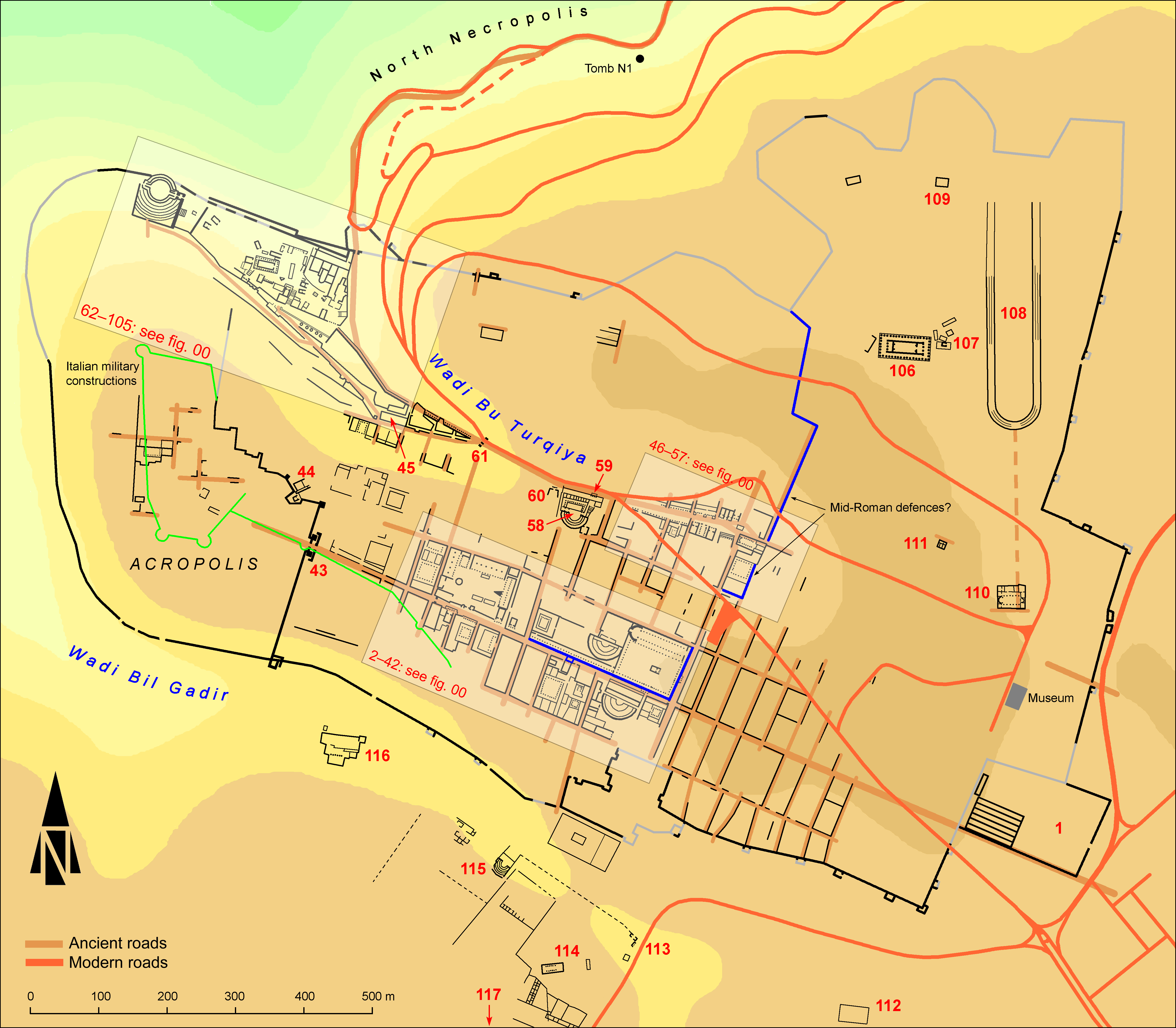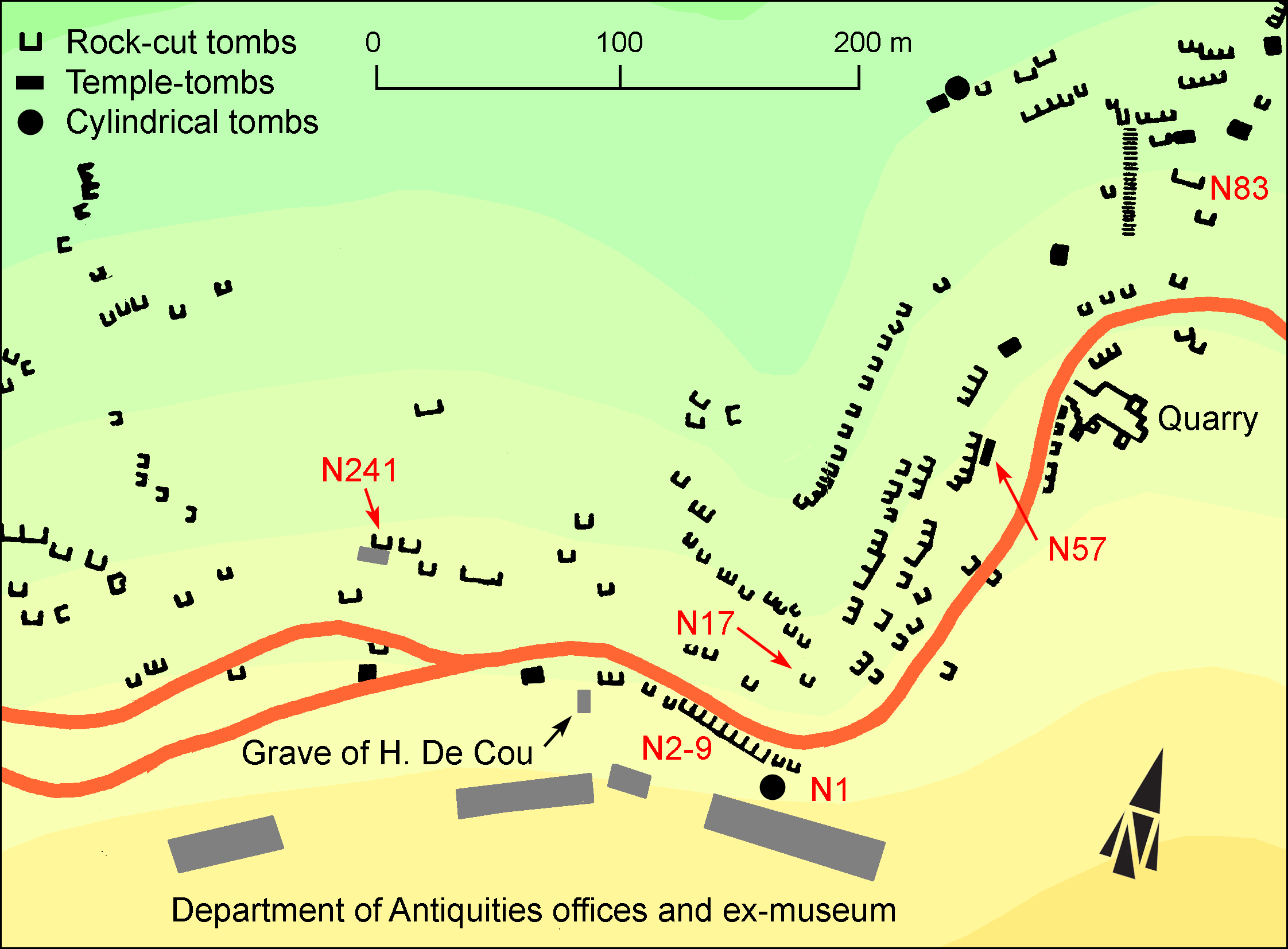Support: Slightly tapered stele of white marble with strongly marked blue veins;
on top, a plain and little projecting moulding
(w: 0.395 × h: 1.10 × d: 0.265);
on the front face, up to the upper ridge, including the moulding, a sculpted palm branch (height 0.18) is standing
in the middle, whereas near the bottom a wreath is sculpted in relief inside a shallow circular recess.
Layout: Inscribed on front face
(w: 0.37 to 0.42 × h: 1.03 × d: 0.25 to 0.28), in 29 lines beginning just under the moulding, so that ll. 1-4 are interrupted
by the palm (marked in the text by spaces).
Letters: 0.016; deeply cut letters without serifs, traces of guide-lines; lettering on the whole similar to that of GVCyr0082, but for the loop of phi at l. 1 which is angled; an ivy leaf stop in l. 27 (end of a verse).
Date: Perhaps second century AD (lettering).
Findspot: Found before 1935 by G. Oliverio at
Cyrene ➚:
together with GVCyr0082 in the same rock-cut tomb of the
North Necropolis.
Place of origin: Findspot.
Last recorded location: Cyrene Sculpture Museum, 251.
Seen by C. Dobias-Lalou in Shahat:
in 1979 in the old Sculpture Museum and again in 2010 in the forecourt of the new Museum, which is since the
years 1990 the only Cyrene Museum.
Text constituted from: Transcription from stone (CDL).
French translation
Translation source: Chamoux 1991
Je fus la fille d'Héphaistous, j'eus Agathangelos pour époux et j'inspire à tous du respect. J'ai nom Parèsia.
Je me suis dépensée en tâches multiples et l'on pouvait toujours compter sur moi.
C'est pourquoi mon époux m'a élevé ici cette stèle comme prix de mes mérites,
pour faire savoir que j'ai reçu la couronne de toutes les vertus:
n'ai-je pas remporté en toutes choses le premier prix?
Et de fait lors des choeurs formés en mon honneur sous les portiques
j'ai vu dans ma maison s'élever le gai tapage des chants bien rythmés.
Les sons aigus de la flûte ont fait résonner mes portiques.
Conduisant le cortège nuptial, Hyménée éveilla les échos de sa douce mélodie.
A plus de soixante ans, je suis descendue dans l'Hadès
et désormais moi, la femme parfaite, l'incomparable en tous points,
je repose, réduite au silence: la stèle parle pour moi.
Qui je fus et de qui je suis née, c'est la stèle qui le dit, car ma bouche est silencieuse.
English translation
I was daughter of Hephaistous and had Agathangelos as a husband, inspiring respect to all. My name is Paresia.
I was busy in many occupations and trustworthy on all occasions.
That is why my husband erected here this stele as an award,
in order to let know that I received the crown of all virtues:
I did in fact carry off the victory crown in all matters.
So did I see, on the occasion of the choruses honoring me under the porches,
the joyful noise of well-rhythmed songs spreading around my house.
The sharp tone of the flute buzzed under my porches.
Leading the bridal procession, Hymenaios echoed with his pleasant melody.
Aged more than sixty years, I went down to Hades
and now, a perfect woman, incomparable in all matters,
I lie, bound to be silent, the stele speaking for me.
Who I was, born to whom, the stele tells it, for my mouth is silent.
Italian translation
Sono stata la figlia di Hephaistous e ho avuto Agathangelos come sposo, a tutti ho ispirato rispetto. Mi chiamo Paresia.
Mi sono spesa in molte occupazioni, in tutte degna di fede.
Per questo lo sposo pose qui per me la stele come premio,
per mostrare che ho ricevuto la corona per tutte le virtù:
in effetti in tutte ho riportato il primo premio.
E in occasione dei cori in mio onore sotto i portici
ho visto in casa mia il lieto rumore ben ritmato dei canti,
l’aulo nei miei portici ha fatto vibrare il suo suono limpido,
Imeneo in processione nuziale ha fatto risuonare la sua dolce melodia.
A più di sessanta anni sono scesa nell’Ade,
e ora, donna perfetta, incomparabile in tutto,
ridotta al silenzio giaccio, parlo grazie alla stele.
Chi sono, da dove vengo, la stele dice, la mia bocca tace.


